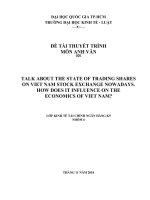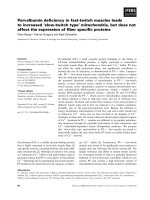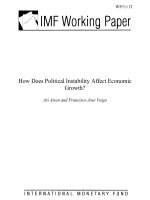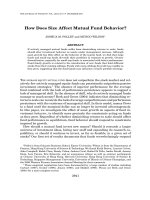How does inflaton affect to unemployment?
Bạn đang xem bản rút gọn của tài liệu. Xem và tải ngay bản đầy đủ của tài liệu tại đây (529.25 KB, 16 trang )
INTRODUCTION TO BANKING AND FINANCE
Instructor: Trần Thị Hoàng Vi
Topic:
How are the effects of inflation to
unemployment?
Group Members
Full name Student ID
Nguyễn Tuyết Ngọc Anh 2008118
Trần Thị Thu Hòa 2009269
Lưu Thanh Huy 2005637
Nguyễn Diệp Phương Linh 2005202
Hình Tăng Phú 2006115
Hồ Thị Bích Trâm 2009269
Ho Chi Minh City, 2014
Contents
MINISTRY OF EDUCATION AND TRAINING
HOA SEN UNIVERSITY
FACULTY OF ECONOMICS AND COMMERCE
INFLATION
Money, Banking and Financial Markets
Instructor: Tran Thi Hoang Vi
1. Definition and classification of inflation
1.1. Definition of inflation
Inflation is when the prices of most goods and services continue to increase
which causes living standard goes down.
How are the effects of inflation to unemployment? 2 | P a g e
Money, Banking and Financial Markets
Instructor: Tran Thi Hoang Vi
How are the effects of inflation to unemployment? 3 | P a g e
Money, Banking and Financial Markets
Instructor: Tran Thi Hoang Vi
1.2. Classification of inflation
1. The rate of inflation
• Moderate inflation: it’s considered to be a moderate inflation and
occurs when the prices are a slow increased less than 10 percent a
year.
• Running inflation: it occurs when the prices rise by more 10
percent a year.
• Galloping inflation: it refers to a situation where the price level
grew dramatically.
• Hyperinflation: it happens when the prices increase over 1000
percent in a year.
2. The nature of time period of occurrence
• War- time inflation: it causes when expenditure is used excessively
on war.
• Post- war inflation: it occurs during the post war.
• Peace- time inflation: government’s expenditure excess over the
revenue.
How are the effects of inflation to unemployment? 4 | P a g e
Money, Banking and Financial Markets
Instructor: Tran Thi Hoang Vi
3. The scope or coverage
• Comprehensive inflation: in all sector or though out the economy,
the price of most of goods grew.
• Sporadic inflation: the price of some goods or to inflation. It occurs
in agricultural sector, at a time.
4. The Government’s reaction
• Open inflation: this is a situation that it has a rapidly rise in prices.
• Repressed inflation: when the prices are prevented from rising up
by governments.
5. The basics of Employment
• Semi inflation: in this case, the prices increase which is
accompanied in production and employments.
• Full inflation: rise in prices is not accompanied in production and
employments.
2. Causes of inflation
There are three main causes: demand-pull, cost-push, monetary expansion.
2.1. Demand pull inflation
Demand-full inflation is the most common
This is the imbalance of supply and demand. The main cause is
aggregate demand increased dramatically, when aggregate supply is
unchanged or not keeping up. In these cases an increase in aggregate
demand (AD) will lead to an increase in prices.
How are the effects of inflation to unemployment? 5 | P a g e
Money, Banking and Financial Markets
Instructor: Tran Thi Hoang Vi
2.2. Cost-push inflation
Cost-push inflation occurs when an economy experiences a negative
cost shock. Causes:
The labor market: form of cost-push inflation arising from
supply side, because of production which has higher cost has
been transferred to the consumer. This can only be achieved in
the period of economic growth as consumers are willing to pay
higher prices.
Import prices: the higher import prices are transferred to the
domestic consumers. The government publishes higher indirect-
tax.
Rising imported raw material costs: rate of exchange increased
or limiting the ability exploit then the cost of raw material
increases
It can be illustrated by an inward shift of the short run aggregate supply
curve. This will show in the diagram below.
How are the effects of inflation to unemployment? 6 | P a g e
Money, Banking and Financial Markets
Instructor: Tran Thi Hoang Vi
2.3. Expansion of the money supply
Money supply is also credit, mortgages and loans.
When the loans are cheap, there will be too much money chasing too
few goods and leading inflation. Prices begin to rise, although either
supply or demand has not changed.
The increase in the money supply is the main reason leading to
increased demand for goods and services. However, it is not the only
reason of increasing demand. Inflationary pressure will increase after
several years, if the demand for a good exceeds supply. The
production has not been extended or using machines with limited
capacity or due to factors of production cannot support an increasing
demand. Imbalances will be disappeared, if the price level rises and
this courses inflation.
How are the effects of inflation to unemployment? 7 | P a g e
Money, Banking and Financial Markets
Instructor: Tran Thi Hoang Vi
3. Positive and negative effects of inflation
3.1. NEGATIVE
a. Increase in interest.
Inflation impacts on many aspects of micro and macro economy through
interest, because interest has effects on sides such as: income, consumption,
investment…
To keep the balance of debit and credit, banking system must maintain stability
of real interest. However, the nominal interest and inflation rate will increase
together, if real interest is constant. Consequently, economy declines and
unemployment rises, when the banks and fiscal institutions make nominal
interest grows with the increase of inflation rate. This result to a sharp fall of the
real investment. Finally, unemployment steadily grows and people‘s life are
harder.
b. The unequal allocation of the national income.
Nominal national income goes up when inflation has growth. This causes
redistribution for different groups of population.
i. Between employers and employees.
When inflation occurred, salary rising is slower than price rising.
Therefore, employers have advantages more than their employees.
ii. Between buyers and sellers main asset.
The majority of main assets have constant nominal interest, so the
bondholders have drawbacks more than the other.
iii. Between two companies.
Merchandises have different rate of rise of price, so enterprises produce
and store goods which have price creeping up will have many
disadvantages.
How are the effects of inflation to unemployment? 8 | P a g e
Money, Banking and Financial Markets
Instructor: Tran Thi Hoang Vi
Inflation has effects on the real value of people‘s wealth. In general,
unanticipated inflation causes some problems such as: transferring the money
from creditor to debter who brings borrower benefit and making a loss to
lender.
Inflation involves perturbation of economy, causes a huge gap between the
poor and the rich, making process of redistribution become irrational and
unequal.
c. Impact on foreign balance.
The exchange rate increases and domestic currency is quickly devalued in
compare with foreign currency because of inflation, which makes the liabilities
become bigger. If the domestic inflation is constant and the foreign inflation
rises, domestic currency will be put up and the liabilities will be reduced.
However, decreasing debit cannot off-set with injuries in manufacture and
production.
3.2. POSITIVE
Higher turnovers and profits: a low stable inflation rate from 1% to 3% allows
businesses to raise their prices, turnovers and profits, while at the same time
workers can expect to see an increase in their salary packers, which might lead
to rising investment and productivity.
Tax revenues: the Government earns revenue from inflation through what is
called “fiscal drag effects”.
Inflation is considered grease, which helps economy to develop. In some
circumstances, the minus real interest is used to adjust consumption, borrow at
interest in order to invest. Therefore, it involves the economic growth and the
decrease of unemployment.
Allowing Government to choose tools so as to operate investment through
extending credit.
Inflation which is controllable and has reasonable level brings economy many
benefits. It becomes the tool to regulate economy.
How are the effects of inflation to unemployment? 9 | P a g e
Money, Banking and Financial Markets
Instructor: Tran Thi Hoang Vi
4. Effects of inflation on unemployment
Analyze the relationship of inflation and unemployment:
When it comes to the relationship between inflation and unemployment, economists
often refer to the concept of “trade-offs”. Offs this means that the loss of the other,
chose this one to give the other. A.W. Phillips found that unemployment tends to
increase the salaries, salary increase will increase the price. Thus, unemployment will
lead to rising inflation. This discovery led to an argument that between inflation and
unemployment trade-off with together. Therefore, this trade-off is shown how? There
must always happen that no trade-off?
4.1. The original Phillips Curve
Based on the experimental results of several years of wages, prices, unemployment
in Britain, it was born and call “the original Phillips curve”
This line show the inverse relationship unemployment and inflation, it is also
consistent with economic realities many Western European countries in 1950s.
Means that haves a trade-off between them.
Phillips curve was built and had form below:
where
o gp: inflation rate
o u : actual unemployment rate
o u*: natural rate of unemployment
o : the Phillips curve slope
The line shows the following characteristics :
Inflation = 0 when actual unemployment rate same natural rate
When actual unemployment below the natural rate, the inflation appear
The larger slope is an increase or decrease of unemployment will cause to
rise or reduction in inflation.
4.2. The short-run Phillips curve:
Nowadays, price don’t lower over time due to expected inflation, therefore the Phillips
curse has been extended by including the expected inflation rate and takes the following
form:
gp
e
: expected inflation rate
How are the effects of inflation to unemployment? 10 | P a g e
gp =
gp = gp
e
- ε(u-u*)
Money, Banking and Financial Markets
Instructor: Tran Thi Hoang Vi
This line shows the actual unemployment in the natural unemployment rate, the
inflation rate expected by. If actual unemployment is higher than the natural
unemployment rate, the inflation rate is lower than expected. This line is called the
short-term Phillips curve corresponding to the period when the inflation rate is not
expected to change. During this period if demand shocks, assuming rapid increase
aggregate demand, the economy along the Phillips curve upward, rising inflation and
unemployment.
How are the effects of inflation to unemployment? 11 | P a g e
Money, Banking and Financial Markets
Instructor: Tran Thi Hoang Vi
4.3. Long-run Phillips curve (LPC)
In short, the unemployment rate may not equal the actual unemployment rate is
expected, but in the long term they will equality by the impact of fiscal policy and
monetary. It is basis for building long-term Phillip curve:
or:
Thus, the actual unemployment rate is always equal to the natural rate of unemployment
(in term of long-term) inflation even changes how. So in the long term inflation and
unemployment do not have a relationship with each other
5. Inflation and unemployment in Vietnam’s context
5.1. Inflation:
Inflation is one of the essential challenges to Vietnam economy. It is also the
reason for slow growth of the state of the economy of Vietnam. Inflation is
considered as the uncontrolled increase in price. It means the devaluation of
Vietnam currency.
How are the effects of inflation to unemployment? 12 | P a g e
0 = -
u = u*
CPI from 2002 to 2012 in Vietnam
Money, Banking and Financial Markets
Instructor: Tran Thi Hoang Vi
Due to the fluctuation of the U.S.A. economy, the exchange rate between VND
against USD changed a lot within general increasing trend which is showed in
the figure beside. As a result, most of enterprises applied USD in their
transaction instead of VND, especially in export goods. Besides that, several of
Vietnamese people who want to save their money in USD. Both of the reasons
make the exchange rate kept moving up more and more.
On the other hand, the payment on the government is one of the biggest reasons,
which cause the inflation. If the government pays more money for goods and
services, the money will go directly into the economy, which cause the higher
demand.
The higher inflation rate in Vietnam relative to its neighbors is explained by the
higher degree of persistence in inflation in Vietnam than in the others. The response of
inflation in Vietnam to national currency depreciation is also greater than in other Asian
countries. This contributes to straining inflationary pressure in Vietnam.
Inflation in Vietnam has been a serious issue in the past, but has recently declined.
o Jan 2012: Vietnam Inflation slowed for a fifth month in January. It climbed
17.27% from a year earlier, compared with an 18.13% pace reported for
December. That will give the Vietnam Central bank more confidence to cut
rates.
o Feb 2012: February CPI rose only 1.37% m/m; up 16.44% y/y and 2.38%
YTD. Although the m/m inflation trend was slightly faster than January’s m/m
CPI of 1% due to the seasonal factors. Indeed, we think this marks a modest
increase in the consumer price index compared to previous years and we are
likely to have the second least inflationary Tet season since FY2007.
How are the effects of inflation to unemployment? 13 | P a g e
Money, Banking and Financial Markets
Instructor: Tran Thi Hoang Vi
o Mar 2012: The March CPI release coming as it did even lower than the
latest predictions were well received. The 0.15% m/m increase was the
lowest in two years and brings the y/y CPI down to 14.15%
5.2. Unemployment:
The unemployment rate in Vietnam is a particular problem. There are some
reasons for this issue. It makes demand and supply of labor unequal, in fact,
more supply than demand so that unemployed has rosin.
Vietnam is a developing country has had to recover from the devastations of war
in the last 35 years. In 1986 the government has introduced the “Doi Moi”
policy (renovation), which has creating good effect in the economy. In order to
modernize the economy and produce more competitive, raising the export;
Vietnamese governors have changed the policy to increase economic
liberalization and ordain structural reforms. The economic has been transformed
from a centrally planned to a market economy since 1986. It accomplished
considerable achievements such as maintaining high growth for a long time.
Vietnam has partially alleviated poverty, rose living standard of people in a
stable political foundation. However, Vietnam is still facing to high rate of
unemployment and especially underemployment.
The Vietnam’s unemployment is contributed by several factors: the natural
increases in population, national economy, monetary and inflation. These factors
can intensify the growth in unemployment.
Unemployment Rate in Vietnam decreased to 2.18 % in the first three-month of
2014 from 2.22 % in the third quarter of 2013. Unemployment Rate in Vietnam
averaged 2.46 %t from 1998 until 2014, reaching an all the time high of 4.5% in
the fourth quarter of 1998 and a record low of 1.81 % in the fourth quarter of
2012. Unemployment rate in Vietnam is reported by the General Statistics
Office of Vietnam
Vietnam calculated its unemployment rate at 1.9 % late in 2013, a figure that
included many well-qualified young unemployed people for more than a year.
The Ministry of Labor, Invalids and Social Affairs said 900,000 people of labor-
age were unemployed in the fourth quarter of 2013, up 5.6 % year on year.
The ministry’s first edition of quarterly labor report said the unemployment rate
in young people (between 15-24 years of age) is around threefold the average
rate and people with college degrees and technical expertise around fourfold.
The high unemployment rate among the qualified group was blamed on either
their pickiness or on the fact that their training did not suit market demands.
Nearly 45 percent of the unemployed are “long-term” cases, defined as being
jobless for more than a year.
A person unemployed for a short term – like from several weeks to several
months – has a better ability to reintegrate into the labor market, while the long-
term unemployed often begin to have problems with their social relationships.
The high long-term unemployment rate could be unsettling the country's social
orders, possibly increasing the rates of crime.
How are the effects of inflation to unemployment? 14 | P a g e
Unemployment rate in Vietnam from 2008 to June 2013
Workforce
%
201220112008 2009 2010
Money, Banking and Financial Markets
Instructor: Tran Thi Hoang Vi
The report forecasts more employment opportunities this year in several sectors
including manufacturing, construction, retail, hospitality and dining services.
Reason:
The unsuitable population unbalance arrange among vary areas and business
lines. Most of the immigrants are form the rural areas. They move to lives in the
big city where placed lots of industrial parks. It makes the urban population is
getting crowed. Therefore, the unemployment rate is always high.
The competition between the firms.
On the other hand, thousands of manufactory has reduced its employees
because of global economics decline and the fiscal crisis in 2008.
6. Conclusion
Inflation and unemployment are the main issues macroeconomic problems. Presidential
elections are often won and lost on the basis of which candidate is able to convince the
public that he or she can best deal with these problems.
Many economists, however, argue that in the long term, maintaining high rates of
growth of real GDP per person is the most important macroeconomic concern. Only
when real GDP per person is increasing will a country’s standard of living increase. In
addition, general speaking, GDP increases or decreases, it depends on how the
How are the effects of inflation to unemployment? 15 | P a g e
Money, Banking and Financial Markets
Instructor: Tran Thi Hoang Vi
government uses economic tools to operate and control country economy such as
printing money, deflation, etc. Consequently, although everything in theory is almost
extremely much easier than in real life, we have to understand methods, equations,
formulas, charts, etc. thoroughly in theory to apply to the real life. If we are not able
hold the balance of economy totally, we will adjust it to the most ideal condition we can
do. With these above, I think governments as well as economists are capable of
controlling inflation and unemployment in the most ideal balance.
Reference
1. />2. />and-unemployment-in-vietnam-economics-essay.php
3.
4. />5. />6. />7. investopedia.com
8. inflationdata.com
9. />relationship-between-inflation-and-unemployment/the-short-run-phillips-curve/
10. />ml
11. />How are the effects of inflation to unemployment? 16 | P a g e









